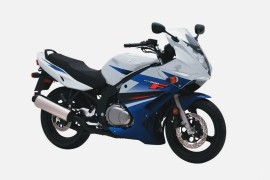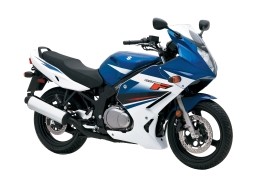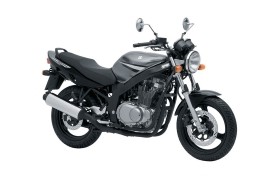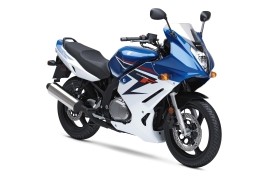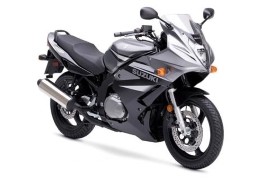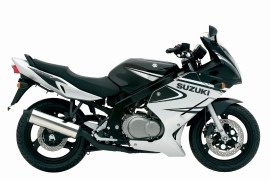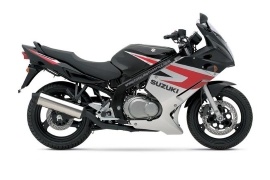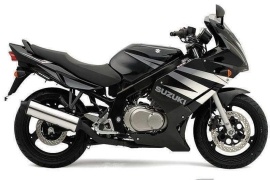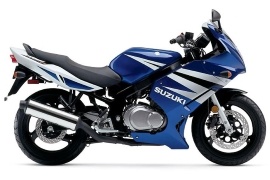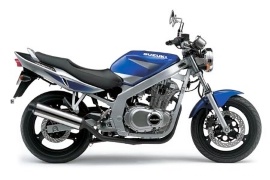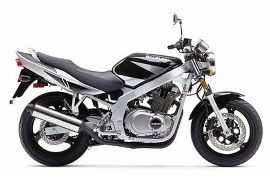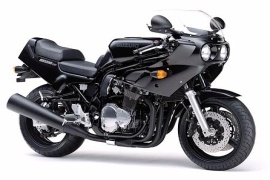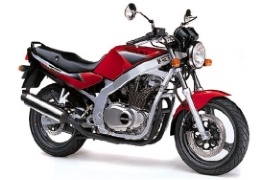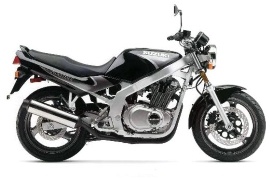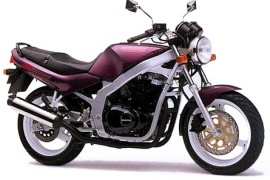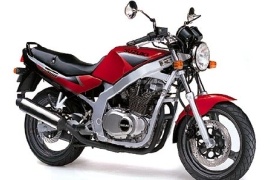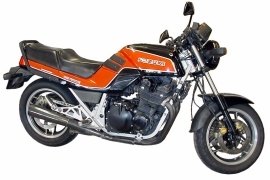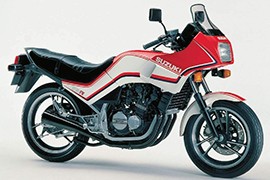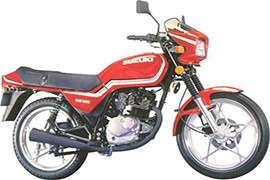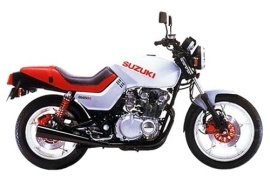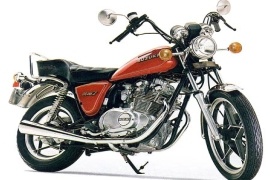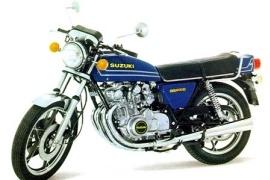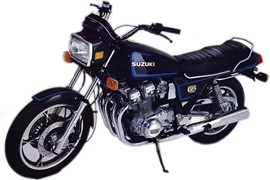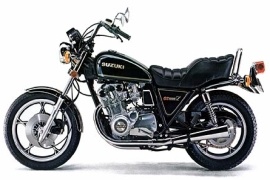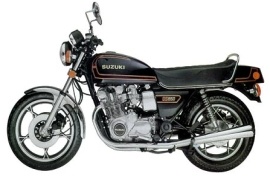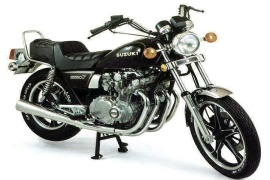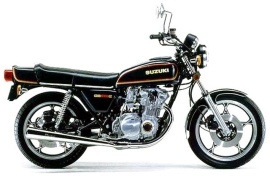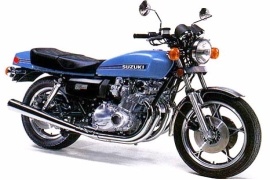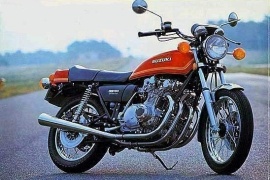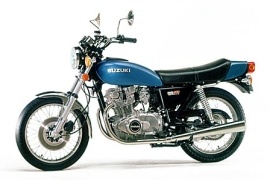SUZUKI GS Models/Series Timeline, Specifications & Photos
First production year: 1976
When Suzuki introduced the GS500F, it offered a new perspective one the old half-liter GS, and adding a hefty dose of modern bike design to keep the interest alive. However, the new model was more successful than anticipated, most likely because it blended the sporty looks with affordability, ease of use and all-rounder functionality. Great for urban and sub-urban commuting, city errands and open-highway fun, this air/oil-cooled parallel twin is agile and lightweight and is a great choice for people who are honing in their rider skills.
And with a 6-speed transmission and low-mid range-focused power and torque deployment, the 2010 MY GS500F is also rider-friendly and offers a reassuring feel for riders in their debut seasons.
Even though the old GS500 has entered a new life stage and is no longer sold in certain markets, there are still a lot of riders who enjoy its mildly sporty character and will go for it. A very good first street bike, but an equally rewarding machine for more seasoned riders, the GS500 is a naked all-rounder which is not shy of almost anything.
Perfect for urban navigation in your daily commuting, great for weekend outings on winding roads and suitable for longer trips when supplied with a luggage system. Air-cooling is keeping an eye on the bike's weight, while the whole compact build makes the GS500 slender and agile.
The 2009 MY GS500F is the smallest member of the GS family, a natural evolution from the naked older models and a very good road-opener for new riders who want to get familiarized with the sport class. Tame, but not lazy, the GS500F introduces a full fairing which provides sporty looks and better wind protection, while the white-blue color scheme harks back to the classic GSX-R machines.
The parallel twin engine is air- and oil-cooled and mated to a compliant 6-speed transmission for optimal power and torque balance in all riding scenarios. Good for a new rider, the GS500F is a fun machine for more experienced ones, as well.
If you're shopping list reads "a naked middleweight commuter which can do anything from streaking through the urban jungle to fast hauls on the highway and everything in between" it;s time to pay a visit to the nearest Suzuki dealers and ask about the GS500E.
This machine is the stripped down version of the GS500F, a nice half-liter bike which is great for both beginners and more experienced riders in search of an economical ride in and around the town, but which also retains a dash of sporty punch. An elementary road going machine, the 2008 MY comes with an air-cooled engine and a single-disc front brake, a generous two-up seat and excellent stance for long hours spent behind the bar.
A step up form the old GS500, the 2008 MY GS500F retains the features of the first generation, packing together the easy-to-master versatility of the half-liter engine and a decent amount of riding fun, while the F suffix introduces the stylish full-faired looks, as well.
With a headlight styled just like the big sporty bikes in the Suzuki stable, the 2008 MY GS500F is an economical commuter which is not shy to ride the extra mile if longer hauls are on the weekend's menu. This middleweight all-rounder with stylish bodywork will not disappoint you, especially as it offers more weather protection than its naked sibling.
Introduced as a 2004 model, the GS500F is the natural evolution from the naked middleweight machine which had pleased generations of beginners and seasoned riders. Upgraded to more sporty looks, the GS500F received a full fairing, a modern headlight and an overall styling overhaul, while retaining the docile, rider-friendly character of the bike.
Versatile, forgiving, exceptionally functional and economic, the GS500F is also light thanks to the air and oil cooling system, adding to the maneuverability and generic performance.
After receiving a solid makeover in the aesthetic department for the previous year, the 2006 MY GS500F carries on the sporty, faired looks, while continually adding to the increasingly better attire. A middleweight bike par excellence, the GS500F now sports an aggressive one-piece headlight with a short windshield and a chin spoiler for impeccable looks.
This entry-level sport bike is easy to master and will prove a most worthy companion for urban commuting and even longer trips, as the bodywork is offering much more protection than what the naked GS500 used to. Add in the good fuel economy and low maintenance costs, and prepare to have more fun aboard this bike than you could ever dream.
A versatile entry-level sporty all-rounder, the 2005 MY GS500F is Suzuki's offer for the riders in search of a bike which can do it all. The GS500F is fully-faired, and this adds to weather protection and cool looks Underneath the fairing you'll find the good-old dependable air-cooled 487 twin and a 6-speed transmission, a package that's fit for both city and highway, easy to understand and use, both thrilling and reassuring.
Sporty and economical, the GS500F serves as a great commuter, but longer trips with a luggage system will not be a problem, either.
The GS 500F is powered by an air-cooled, 487 cc, DOHC, four-valve parallel twin with 34mm Mikuni carburetos and a slick-shifting six-speed transmission. The new fairing features a pair of vertically stacked headlights that bear a striking resemblance to those on the hugely popular GSX-R1000 This Suzuki, with a 55.5-inch wheelbase and a perimeter-style steel-tube frame with sporty geometry, is fitted with competent suspension and brakes.
It doesn't take a Suzuki specialist to figure out that the 2004 MY GS500F is the faired version of the old GS500E machine, as the final F is pretty self-explanatory. The GS500F represents a new stage in the history of the half-liter commuter, introducing better weather protection for the rider, a more aggressive appearance and better cooling efficiency thanks to the air channeling technology.
Under the new bodywork, you'll meet a 6-speed 487cc parallel-twin engine, pretty much the same unit in the GS500E, This means you'll be in charge of 47 hp and 40 Nm, pretty decent figures for an all-rounder, beginner-friendly bike just under 180 kg.
The 2003 MY GS500E is a no-frills half-liter air and oil-cooled machine which simply gets the job done. Great as an all-rounder for the asphalt roads, the GS500E is an economical commuter, too. perfect for slicing the city at rush hour, it will also feel great on the open highway.
With room for two, this bike boasts naked simplicity: an easy to maintain parallel twin engine, no fairings to crash when the bike flips over, cast wheels and a manual 6-speed which will feel great both in the urban environment and on countryside roads.
Equally suitable for a first bike and a daily ride for more experienced riders, the 2002 MY GS500E has all the right feats to make almost everyone happy. Fun, non-intimidating and fairly powerful to not be easily outgrown, the GS500E offers plenty of bike for your money.
With 47 hp and a light build, the 2002 MY GS500E si easy on your budget and can do pretty much anything a sporty naked bike can. Great as an economical commuter, highly maneuverable on any roads and offering an upright riding position, this bike belongs to the middleweight all-rounder elite.
The GS 1200 SS is a full modern bike, although in some details the GS 1200 SS is still old-fashioned. For example, the speed and the rev counter were wire-connected instead of electric, like in many other modern bikes. Still, the dry mass of the bike was only 210 kg (462 lbs), making the bike go really fast with its 100 hp (74.6 Kw) engine.
Sometimes referred to as the small Bandit, the 2001 MY GS500E is a middleweight sporty, naked bike which can be used for both commuting, canyon carving fun and even road touring, when equipped with accessory luggage systems. Lightweight and providing effortless handling, the GS500E provides a rewarding ride to both new and more experienced motorcyclists, while its upright riding position is comfy for hours in a row.
The air-cooled parallel twin engine is mated to a 6-speed gearbox which makes city slicing and highway hauls an effortless business and the GS500E an excellent no-frills, economical and fun commuter, too.
If you're looking for a fun middleweight bike for urban commuting and all sorts of two-wheeled fun, the 2000 MY GS500E is a very good choice, especially as "affordability" is its middle name. The bike packs plenty of punch to be fun even for seasoned riders, and for an 192 kg (wet) machine, 47 horsepower will be just right to make things non-intimidating and reassuring.
This parallel twin also packs plenty of room for a passenger, making a great commuter for two in the warm season. Still, adding a luggage system will also make it suitable for longer trips, as well.
For 11 years, from 1976 until 1987, Suzuki manufactured the GS line of motorcycles, all of which were powered by four-stroke air-cooled engines with displacements between 250cc and 1100cc.
In 1976, Suzuki offered the GS 400, GS 550, and GS 750, which were similar in design, with two-valve per cylinder, double overhead camshafts, telescopic fork, and packed an electric starter.
In 1991, Suzuki launched the GS 400 E, an authentic V-twin engine motorcycle packed with a European flavor.
The model was powered by a 400cc engine that generated high torque at low rpm, packed in a durable angular pipe cradle frame, with a large-capacity 17-liter fuel tank, a specially shaped seat for tandem touring, and grab bars, which overall generated a natural and comfortable riding position with fun-to-ride experience for touring and city streets.
In the power department, the 399cc four-stroke two-cylinder air-cooled engine with a power output of 39 hp at 9,500 rpm and 31 Nm (23 lb-ft) of torque at 8,000 rpm combined with a six-speed manual transmission and a dry weight of 169 kg (373 lbs), the 1991 Suzuki GS 400 E registered a top speed of 165 kph (102 mph).
The model featured disc brakes and wide tires both front and rear, for better cornering and riding performance.
Suzuki GS 500E launched as an unfaired roadster. Very few, minor tweaks (front forks became adjustable, as did the brake lever, it got lower bars etc) until 2001 when it was discontinued. The Suzuki GS 500E probably performs best in town where a bit of low down grunt can see you out of any nasty entanglements.
The Suzuki GS 1150 was first full range of 4-stroke powered road motorcycles, having previously almost exclusively manufactured 2-stroke machines.
The Suzuki GS 250FW motorcycle is more normally sized, scaled-down to about 90 percent of a typical 550. Shorter people fit it best, but even a six-footer isn't cramped. The styling, which is reminiscent of an '83 Suzuki GS 750E, is only medium-sporty rather than effecting the pure racing look that is typical of the hot-rod 250s sold in Japan.
The Suzuki GS 125E's four stroke single cylinder motor is virtually bulletproof, but makes a claimed 12 hp eventually. Relatively roomy seat, tiny nose fairing and a digital gear indicator on later model Suzuki GS 125E`s are the main highlights, on what is otherwise a basic, no-frills mode of transport. The Suzuki GS 125E does have a centrestand however, which some 125cc custom/commuters lack.
Unlike the others models in the Katana lineup, the shaft drive 650 is a completlely new bike. The 650 series is different from the 50 horsepower engine only with a more heavily dimensioned fork with adjustable spring preload, 17 in rear wheel, more caster and 34 extra pounds.
The base of the bikes was the two-pillager of the popular GS 400, whose origins originated from 1976. But you can make everything better and so the engineers gave the Twin a general cure. A cylinder drill of 71 mm was installed and the stroke reduced from 60 to 56.6 mm. This resulted in an increase in displacement to 448 cc .
The Suzuki GS 500E probably performs best in town where a bit of low down grunt can see you out of any nasty entanglements. Elsewhere, however, the GS 500E's a chore to get it up to speed. High mileages are common, which is a good sign, but the whole set up needs to be updated to keep the Suzuki GS 500E in touch with modern competitors.
The GS 1100 had a 1074 cc engine (the figure refers to the volume of space swept by the pistons) and was a four-stroke, which means it takes four piston strokes to complete an engine cycle. The engine's four cylinders were arranged in a line. The valves were controlled by a double overhead cam system, whereby a camshaft directly operated the intake and exhaust valves.
Suzuki introduced another shaftie in 1980 fitting a shaft drive the GS 1000L, GS 1000GL used the same mechanics as the GS1000G but borrowed the style of the GS 1000L with smaller fuel tank, high handlebars and stepped seat. Notice the different front fork. The beefy air-cooled engine was a real hammer and offered as a short stroke with a stroke-bore ratio of 64.8 x 70 mm a respectable capacity of 997 cc. Although only two valves per cylinder in the DOHC head Celt, 90 hp (68 Kw) at the crankshaft roller bearings were solid given and much more important for a chopper 81 Nm at 7,000 rpm
The GS850 G was introduced on February, 1979. From the very beginning, the machine had a 5 speed gearbox, both electric and kick start and a shaft drive.
The Suzuki GS 550 L is a typical representative of the so-called soft- chopper generation (construction period from 1979 to 1984). Originated from the successful and more sporty 550 E , the 550 L has an extended fork, a chopper steering wheel, a reduced tank and a bench seat.The L models of the GS series enjoyed great popularity, particularly in their "large" variants 750 L, 850 L and 850 GL, 1000 L and 1000 GL as well as 1100 L and 1100 GL, particularly on the US market , Which also explains their long construction period. The end of the GS series represents the futuristic styled GSX 1100 Katana.
The Suzuki GS 550E is in the mainstream of the 1970`s tradition. This bike has four-cylinder, four carburetors, dual overhead camshafts, disc brakes and cast wheels. The 550E is a variant of the GS 550N with the same chassis, but with two different engines.
The Suzuki GS 1000E was based around the successful GS 750, which was the lightest of the 750's available at the time. What Suzuki wanted was a simple design, that benefited from solid engineering and light weight. And they succeeded. The GS 1000E was only slightly heavier than its smaller brother, which was quite an achievement. By lengthening the stroke of the (relatively short stroke) GS 750 engine from 56,4 to 70 mm the cylinder displacement was enlarged from 748 to 997 cc.
Suzuki introduced the popular Suzuki GT 750, a water-cooled 2-stroke triple, in 1971, but knew the days of the “Water Buffalo” (as it was known on the street) were numbered thanks to ever tightening emissions regulations in the U.S. and Europe.
With the Suzuki GS 400, the Japanese manufacturer introduced a motorcycle in the fall of 1976, which was soon to become a popular entry-level machine. At the beginning, the motorcycle had 34 hp at 8,500 rpm, but was throttled from May 1977 to an insurance-friendly 27 hp at 7,400 rpm. Deceleration is, in principle, possible, but very complex, because the camshaft has to be replaced. The GS 400, however, is one of the cases in which the motorcycle has also gained some weight because of the throttling, because the usable speed band became significantly larger.
